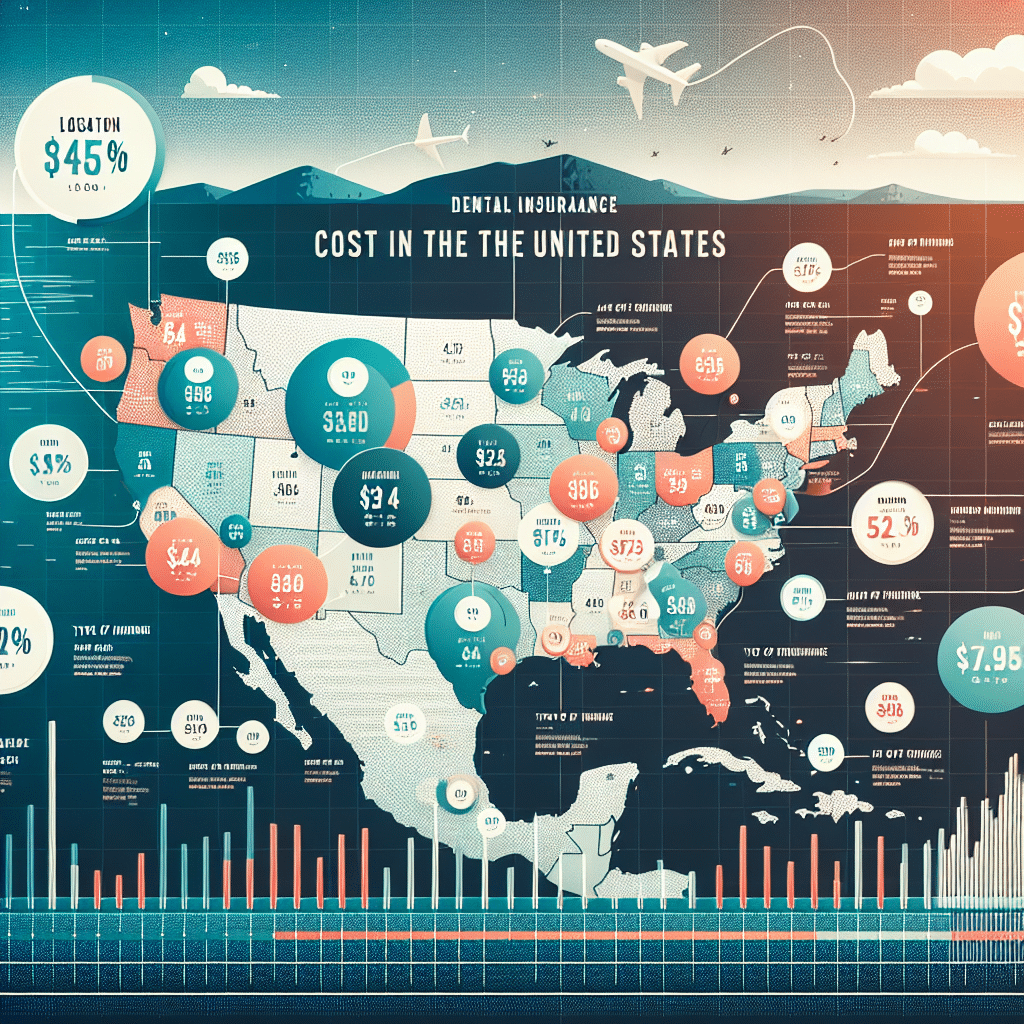The Importance of Regular Dental Check-Ups in Reducing Long-Term Dental Insurance Costs
Dental care is an essential aspect of overall health and well-being. However, many people tend to neglect their oral health due to various reasons, including the high cost of dental care. In the United States, dental insurance is an important tool that helps individuals and families manage the cost of dental treatments. But how much does dental insurance cost in the United States, and is it worth the investment?
The cost of dental insurance in the United States varies depending on several factors, including the type of plan, coverage, and location. On average, an individual can expect to pay around $350 per year for basic dental insurance, while a family plan can cost up to $1,500 annually. These costs may seem high, but they are significantly lower than the out-of-pocket expenses for dental treatments without insurance.
One of the main reasons why dental insurance is crucial is that it encourages individuals to seek regular dental check-ups. Many people only visit the dentist when they experience pain or discomfort, which often indicates a more severe dental issue. By having dental insurance, individuals are more likely to schedule routine check-ups and cleanings, which can help prevent more significant and costly dental problems in the long run.
Regular dental check-ups are essential in maintaining good oral health. During these visits, dentists can detect any potential issues early on and provide necessary treatments before they worsen. This not only saves individuals from the pain and discomfort of dental problems but also reduces the need for expensive and extensive treatments in the future.
Moreover, dental insurance often covers preventive services such as cleanings, X-rays, and fluoride treatments at little to no cost. These services are crucial in preventing tooth decay and gum disease, which are the leading causes of tooth loss. By investing in dental insurance and utilizing these preventive services, individuals can save a significant amount of money in the long run by avoiding costly treatments for tooth loss.
Another benefit of dental insurance is that it can cover a portion of the cost for more extensive and necessary dental treatments. For example, if an individual needs a root canal or a crown, dental insurance can cover a significant portion of the cost, making it more affordable. Without insurance, these treatments can cost thousands of dollars, putting a significant financial strain on individuals and families.
Furthermore, dental insurance can also provide coverage for orthodontic treatments, such as braces. These treatments are often necessary for correcting misaligned teeth, which can lead to various dental problems if left untreated. While orthodontic treatments can be expensive, dental insurance can help make them more affordable, allowing individuals to achieve a healthy and beautiful smile without breaking the bank.
In addition to the financial benefits, dental insurance also offers peace of mind. Knowing that you have coverage for dental treatments can alleviate the stress and worry of unexpected dental issues. This can also encourage individuals to seek treatment for any dental problems they may have, rather than ignoring them due to financial concerns.
In conclusion, dental insurance is a crucial investment in maintaining good oral health and reducing long-term dental costs. By encouraging regular check-ups and covering preventive and necessary treatments, dental insurance can save individuals and families from the financial burden of expensive dental procedures. So, if you are considering dental insurance, remember that it is not just an added expense, but a valuable tool in promoting overall health and well-being.
How to Save Money on Dental Insurance in the United States

Dental care is an essential aspect of overall health and well-being. However, the cost of dental procedures and treatments can be a significant financial burden for many individuals and families in the United States. This is where dental insurance comes in, providing coverage for various dental services and helping to alleviate the financial strain. However, dental insurance can also be costly, and finding ways to save money on it is crucial. In this article, we will discuss some tips on how to save money on dental insurance in the United States.
First and foremost, it is essential to understand the different types of dental insurance plans available in the United States. The most common types are preferred provider organization (PPO) plans, health maintenance organization (HMO) plans, and dental discount plans. PPO plans offer a network of dentists that provide services at a discounted rate, while HMO plans require you to choose a primary care dentist who will coordinate all your dental care needs. Dental discount plans, on the other hand, offer discounted rates for dental services but do not provide coverage. Understanding the differences between these plans can help you choose the one that best fits your needs and budget.
One way to save money on dental insurance is to opt for a high deductible plan. A deductible is the amount you must pay out of pocket before your insurance coverage kicks in. High deductible plans have lower monthly premiums, making them a more affordable option. However, it is essential to consider your dental needs and budget before choosing a high deductible plan. If you require frequent dental care, a high deductible plan may not be the most cost-effective option.
Another way to save money on dental insurance is to take advantage of employer-sponsored plans. Many employers offer dental insurance as part of their employee benefits package. These plans often have lower premiums and more comprehensive coverage than individual plans. If your employer offers dental insurance, it is worth considering enrolling in it to save money.
It is also crucial to research and compare different dental insurance plans before making a decision. Many insurance companies offer online tools that allow you to compare plans and their costs. Take the time to review the coverage and costs of each plan to determine which one offers the best value for your money. Additionally, consider asking for recommendations from friends and family who have dental insurance to get an idea of which companies offer the best coverage and rates.
Another way to save money on dental insurance is to take advantage of preventive care benefits. Most dental insurance plans cover preventive services such as cleanings, exams, and X-rays at no cost or a minimal cost. By regularly visiting your dentist for preventive care, you can avoid more expensive and extensive dental procedures in the future. This can save you money in the long run and keep your oral health in check.
Lastly, consider bundling your dental insurance with other types of insurance, such as health or vision insurance. Many insurance companies offer discounts for bundling multiple types of insurance, which can help you save money on your overall insurance costs.
In conclusion, dental insurance can be costly, but there are ways to save money on it. Understanding the different types of plans, opting for a high deductible plan, taking advantage of employer-sponsored plans, researching and comparing plans, utilizing preventive care benefits, and bundling insurance can all help you save money on dental insurance in the United States. By following these tips, you can ensure that you have access to quality dental care without breaking the bank. Remember, investing in your oral health is an investment in your overall well-being.
Understanding the Different Types of Dental Insurance Plans and Their Costs
Dental insurance is an important aspect of overall healthcare in the United States. It helps individuals and families cover the costs of routine dental care, as well as unexpected dental procedures. However, with the variety of dental insurance plans available, it can be overwhelming to understand the different types and their associated costs. In this article, we will break down the different types of dental insurance plans and their costs, so you can make an informed decision when choosing the right plan for you and your family.
The first type of dental insurance plan is the traditional fee-for-service plan. This plan allows you to choose any dentist you want, and the insurance company will pay a percentage of the cost for covered procedures. Typically, this percentage ranges from 50% to 80%, depending on the procedure. The remaining balance is then paid by the patient. This type of plan usually has a deductible, which is the amount you must pay out of pocket before the insurance company starts covering costs. The deductible can range from $50 to $1000, depending on the plan.
Another type of dental insurance plan is the preferred provider organization (PPO) plan. With this plan, you have a network of dentists to choose from, and if you visit a dentist within the network, you will receive a discounted rate. However, if you choose to see a dentist outside of the network, you will have to pay a higher percentage of the cost. PPO plans also have deductibles and co-payments, which are a fixed amount you must pay for each visit or procedure. The deductible and co-payment amounts vary depending on the plan.
A third type of dental insurance plan is the health maintenance organization (HMO) plan. This plan works similarly to a PPO, but with more restrictions. You must choose a primary care dentist from a network of dentists, and you can only see dentists within the network. HMO plans do not have deductibles, but they do have co-payments for each visit or procedure. The co-payment amounts are usually lower than PPO plans, but you have less flexibility in choosing your dentist.
In addition to these traditional dental insurance plans, there are also discount dental plans. These plans are not insurance, but rather a membership program that offers discounted rates for dental procedures. You pay an annual fee to become a member, and then you can receive discounted rates at participating dentists. These plans are often more affordable than traditional insurance plans, but they do not cover as many procedures.
Now that we have discussed the different types of dental insurance plans, let’s talk about their costs. The cost of dental insurance varies depending on several factors, including the type of plan, the coverage level, and the location. On average, dental insurance can cost anywhere from $15 to $50 per month for an individual and $30 to $150 per month for a family. However, these costs can be higher or lower depending on the factors mentioned above.
It is also important to note that dental insurance plans often have annual maximums, which is the maximum amount the insurance company will pay for covered procedures in a year. This can range from $1000 to $3000, depending on the plan. Once the annual maximum is reached, you will be responsible for paying the full cost of any additional procedures.
In conclusion, dental insurance is an essential aspect of overall healthcare in the United States. Understanding the different types of plans and their associated costs can help you make an informed decision when choosing the right plan for you and your family. Whether you opt for a traditional fee-for-service plan, a PPO, an HMO, or a discount plan, it is crucial to carefully consider your needs and budget to find the best fit for your dental care needs. Remember to also factor in the annual maximum and any deductibles or co-payments when comparing plans. With the right dental insurance plan, you can ensure that you and your family have access to quality dental care without breaking the bank.
Factors Affecting Dental Insurance Cost in the United States
Dental insurance is an important aspect of overall healthcare in the United States. It helps individuals and families cover the cost of dental procedures, which can be quite expensive without insurance. However, the cost of dental insurance can vary greatly depending on several factors. In this article, we will explore the various factors that affect dental insurance cost in the United States.
One of the main factors that affect dental insurance cost is the type of plan chosen. There are two main types of dental insurance plans – indemnity plans and managed care plans. Indemnity plans, also known as traditional plans, allow individuals to choose their own dentist and pay a percentage of the cost for each procedure. On the other hand, managed care plans, such as Health Maintenance Organizations (HMOs) and Preferred Provider Organizations (PPOs), have a network of dentists that individuals can choose from and offer lower out-of-pocket costs. Generally, managed care plans have lower premiums compared to indemnity plans, making them a more affordable option for many individuals.
Another factor that affects dental insurance cost is the level of coverage provided by the plan. Most dental insurance plans cover preventive care, such as routine cleanings and check-ups, at 100%. However, coverage for more extensive procedures, such as fillings, root canals, and crowns, may vary. Plans with higher coverage levels will have higher premiums, but they can also save individuals money in the long run if they require more extensive dental work.
The location of an individual also plays a role in the cost of dental insurance. Dental insurance premiums can vary from state to state due to differences in the cost of living and the availability of dentists. For example, states with a higher cost of living, such as California and New York, may have higher dental insurance premiums compared to states with a lower cost of living, such as Texas and Florida. Additionally, the availability of dentists in a particular area can also affect the cost of dental insurance. Areas with a higher concentration of dentists may have more competitive pricing for dental insurance plans.
The age of an individual is another factor that affects dental insurance cost. Generally, younger individuals have lower premiums compared to older individuals. This is because younger individuals are less likely to require extensive dental work, making them a lower risk for insurance companies. As individuals age, the risk of dental problems increases, and therefore, the cost of dental insurance also increases.
The type of dental procedures covered by the insurance plan also affects the cost. Basic procedures, such as cleanings and fillings, are typically covered by all dental insurance plans. However, more complex procedures, such as orthodontic treatment and dental implants, may not be covered or may require additional premiums. It is essential to carefully review the coverage of a dental insurance plan to ensure that it meets an individual’s specific needs.
Lastly, the number of individuals covered under a dental insurance plan can also affect the cost. Family plans, which cover multiple individuals, will have higher premiums compared to individual plans. However, family plans can also provide cost savings for families with multiple individuals requiring dental care.
In conclusion, several factors affect the cost of dental insurance in the United States. These include the type of plan chosen, the level of coverage provided, location, age, type of procedures covered, and the number of individuals covered. It is essential to carefully consider these factors when choosing a dental insurance plan to ensure that it meets an individual’s specific needs and budget. With the right dental insurance plan, individuals can have peace of mind knowing that their dental health is covered, and they can receive the necessary care without breaking the bank.

